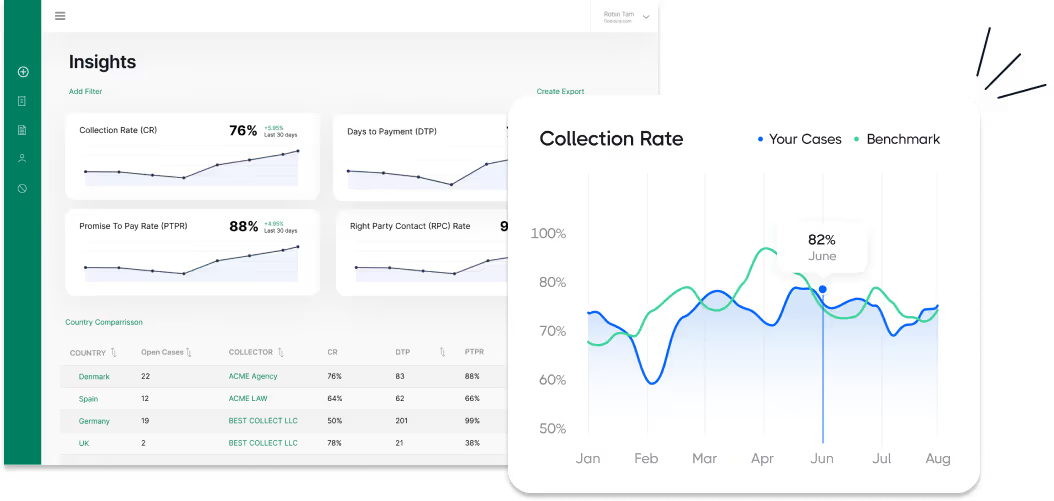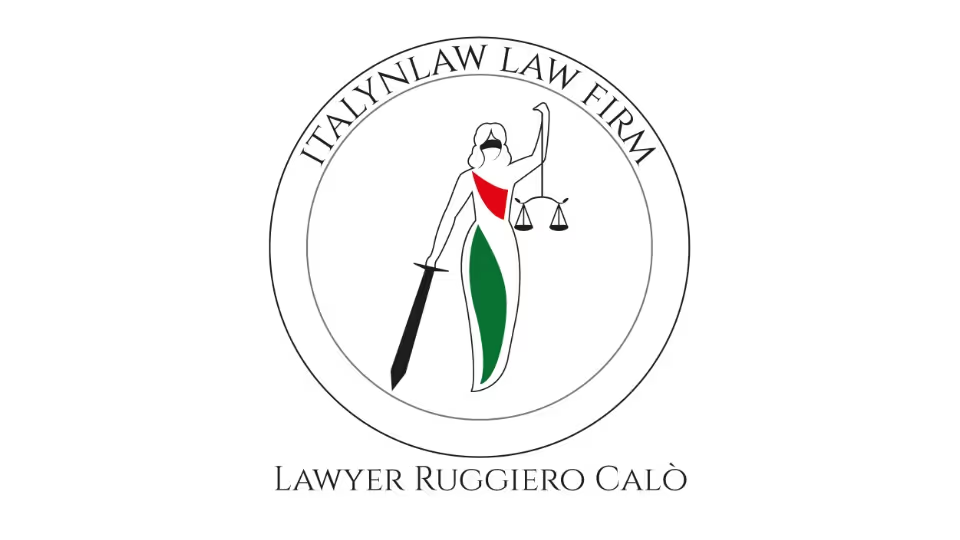Top-Rated Debt Collection Agency in Italy
Fast and reliable debt collection in Italy - no upfront costs, only pay for success. Request a FREE Consultation or upload your claim today.






The Ultimate Guide to Debt Collection in Italy
Why you can trust this guide
At Debitura, we uphold the highest standards of impartiality and precision to bring you comprehensive guides on international debt collection. Our editorial team boasts over a decade of specialized experience in this domain.
Questions or feedback? Email us at contact@debitura.com — we update this guide based on your input.
Debitura By the Numbers:
- 10+ years focused on international debt collection
- 100+ local attorneys in our partner network
- $100M+ recovered for clients in the last 18 months
- 4.97/5 average rating from 600+ client reviews
Expert-led, locally validated
Written by Robin Tam (16 years in global B2B debt recovery). Every page is reviewed by top local attorneys to ensure legal accuracy and practical steps you can use.
Contributing local experts:
Last updated:
Welcome to Debitura, your premier partner in navigating through the intricacies of debt collection in Italy. With a decade of unmatched experience and a unique blend of local expertise backed by global insights, this guide is your ultimate companion for efficient debt recovery in Italy. Let Debitura be your cornerstone to success in this complex process.
Key Actors in Italian Debt Collection
In the intricate world of debt recovery in Italy, understanding the roles and responsibilities of various key players is crucial. From debt collection agencies and court bailiffs to specialized lawyers, each has a distinct part in the orchestrated effort to recover debts while adhering to Italy's stringent legal framework.
Debt Collection Agencies in Italy
Debt collection agencies in Italy serve as intermediaries between creditors and debtors, focusing primarily on extrajudicial recovery methods. These agencies are involved at the early stages of debt recovery, employing various tactics such as sending payment reminders and negotiating payment plans. In Italy, agencies must operate with a "Licenza di Recupero Crediti" issued by the Questura, and they are strictly forbidden from practices deemed as harassment or violation of debtor’s privacy. Their role is pivotal in attempting to recover debts without resorting to the courts.
Debt Recovery Lawyers (Avvocati) in Italy
For judicial debt recovery in Italy, engaging a specialized lawyer becomes imperative, especially in complex cases where extrajudicial efforts have failed. Lawyers navigate the multitude of legal procedures involved in debt recovery, from issuing formal payment demands to initiating forced asset recovery. Their expertise is critical for managing both national and cross-border debt recovery cases within the EU. Operating under Italy’s civil procedure code, lawyers ensure that debt recovery actions are legally sound and effectively executed.
Bailiffs (Ufficiali Giudiziari) in Italy
In Italy, judicial officers, known as Ufficiali Giudiziari, are essential when enforcing legal judgments, including debt collections. Their involvement is required after obtaining an executive title through a judge's order. Performing crucial tasks like asset garnishment and delivering official notices, bailiffs operate under a strict legal framework outlined by DPR 15/12/1959, n. 1229. Their activities are invaluable for creditors pursuing forced recovery, ensuring the legal enforcement process is carried out with precision and authority.
Italian Debt Collection Laws and Regulations
Successfully recovering debts in Italy requires a thorough understanding of its complex legal framework. Compliance with these laws ensures not only effective debt recovery but also upholds the principle of fairness in the procedure, essential for sustaining trust and integrity in business practices.
The Regulatory Environment and Civil Court System in Italy
Italy's civil court system is pivotal in the debt recovery process, structured on different levels for handling civil litigation:
- Peace Judges (Giudice di Pace): Handle smaller claims and minor disputes.
- Tribunals (Tribunali): Address most civil cases, including those related to debt collection.
- Courts of Appeal (Corte d'Appello): Deal with appeals from lower court decisions.
- Supreme Court of Cassation (Corte di Cassazione): The highest court level, addressing matters of law and procedure.
The Debt Collection Agency Activity is regulated under Article 115 of the T.U.L.P.S. (Testo Unico delle Leggi di Pubblica Sicurezza) and the D.L. 08 April 2008 n. 59, which oversees the licensing and operation of debt collection agencies.
Key Legislation Impacting Debt Collection in Italy
The Italian legal framework provides a comprehensive approach to debt collection, focusing on creditor and debtor rights:
- Civil Procedure Code: Defines the judicial procedure for debt collection, including execution processes.
- Consumer Code and Personal Data Protection Code: These laws protect consumers against abusive debt collection practices and ensure the privacy and dignity of the debtor are respected.
- Bankruptcy Law (Legge Fallimentare): Governs insolvency and restructuring proceedings, detailing creditor rights and priorities.
- Article 29 of D.L. 78/2010 and subsequent modifications: Specific to tax collection, this legislation allows for executive assessment in the collection phase.
Complex regulations and recent legislative changes, such as the 2023 Budget Law (Law n. 197/2022) for debt cancellation, reflect the evolving landscape in debt collection law.
Consumer Protection and Fair Debt Collection Practices in Italy
In Italy, consumer protection against unfair collection practices is a cornerstone of debt recovery legislation:
- Engagement regulations prevent the use of intimidation, undue pressure, or misleading practices.
- Debtors have the right to a clear notification of the debt, including details on the amount, creditor, and dispute process.
- Privacy and dignity must be preserved, prohibiting the disclosure of debtor’s information without consent.
- Consumers aggrieved by collection practices have the right to redress through complaint to the Personal Data Protection Authority or legal action for damages.
These protections illustrate Italy’s dedication to fair and ethical debt recovery, balancing creditor rights with consumer dignity and privacy.
Overview of the Amicable Collection Process in Italy
Pre-legal debt collection in Italy provides a less formal approach for creditors to reclaim debts through negotiation and agreement. This section explores the essential steps performed typically by debt recovery agencies, such as Debitura, and what stakeholders can anticipate from the process.
- Initial Verification: Confirmation that the debt is certain, liquid, and due with all necessary documentation.
- Friendly Approach: Utilizing emails, phone calls, and home visits to negotiate payment terms with flexibility.
- Preliminary Analysis: In-depth review of debtor's information to support recovery.
- Structured Process: Recovery strategy includes multiple steps to negotiate payment.
- Debtor Untraceability: Declaration of untraceability if the debtor disappears, possibly accessing tax benefits.
- Emphasis on Respect: Maintaining respect and empathy towards debtors to facilitate settlement.
- Use of Digital Tools: Advanced software and digital platforms enhance case management efficiency.
- Transition to Judicial Recovery: Escalating to judicial recovery if amicable efforts fail.
- Typical Steps: Includes investigations and reminders before considering legal action.
- Flexibility in Practice: Approaches may vary based on debt type, with an emphasis on technological efficacy.
Exploring Effective Debt Recovery in Italy through Amicable Methods
Amicable debt collection centers on a strategy that fosters strong relationships during the recovery process, prioritizing understanding and dialogue instead of conflict. This technique ensures that while the creditor's financial interests are safeguarded, the debtor's circumstances are respected, promoting outcomes that are fair to both parties. This cooperative method is best suited for straightforward claims, sidestepping the need for costly and complicated legal proceedings.
It's advisable to attempt amicable debt collection first, except in cases where the claim is contentious or entangled in intricate legal matters.
The Crucial Role of Collection Agencies in Amicable Settlements in Italy
In the realm of amicable settlements, collection agencies play a critical role, particularly for creditors who might not have the resources or knowledge to carry out efficient debt recovery. Agencies such as Debitura excel by first accurately pinpointing the debt and debtor, then proceeding with direct communication via reminders or official notifications. Their neutral perspective, free from any emotional ties, frequently culminates in more effective debt resolution, thanks to their impartial and expert intervention.
Benefits of Choosing Amicable Debt Resolution
Opting for an amicable approach in debt recovery is advantageous for all involved parties; it allows creditors to cut down on legal expenses and maintain important business connections, courtesy of the method's considerate nature. Debtors benefit from more flexible repayment conditions, alleviating financial pressure and promoting goodwill towards the creditor. This method is built on mutual respect and comprehension, paving the way for a more agreeable settlement of financial duties.
Switching from Amicable Solutions to Judicial Proceedings
Although amicable solutions bring numerous advantages, there are scenarios where legal intervention becomes necessary. Indications for transitioning to legal proceedings include lack of response, repeated failure to fulfill commitments, or intentional avoidance by the debtor. Opting for legal action is a significant decision, to be taken after all amicable avenues have been explored, due to the substantial financial and temporal demands of legal processes.
Judicial Debt Collection In Italy
When it comes to judicial debt collection in Italy, creditors navigate a complex legal landscape involving court orders and legal proceedings. Discover key insights about debt recovery in Italy below.
- Dedicated Offices: Specific offices within tribunals manage debt recovery activities, facilitating documentation preparation and debt monitoring.
- Judicial vs Amicable: Assessing a debtor's financial situation is crucial before pursuing legal action, favoring amicable settlements for efficiency.
- Costs Involved: Variable legal and administrative costs impact the financial burden on creditors during debt recovery.
- Recovery of Costs: Creditors can seek compensation from debtors for extrajudicial recovery expenses, reducing financial impact.
- Small Claims Procedure: The Giudice di Pace court offers streamlined proceedings for civil cases under €5,000, providing a cost-effective option.
- Court Order Initiation: Obtaining an injunction for unpaid debts involves filing a petition at the competent court, requiring evidence of credit ownership.
- Recovery Timeline: Judicial debt recovery timelines vary significantly and can be extended by debtor opposition or lawsuits.
- Court Hierarchy: Different courts handle cases based on nature and amount, impacting duration and complexity of recovery proceedings.
- Representation & Appeal: Legal representation is required for claims over certain amounts, with both parties having the right to appeal court decisions.
- Enforcement of Judgment: Following a favorable ruling, creditors can execute judgment through measures like asset seizure, finalizing debt collection.
Shifting from Amicable to Judicial Debt Collection in Italy
Understanding the nuances between amicable and judicial debt collection is crucial for creditors seeking recovery in Italy. Unlike amicable collection, which utilizes negotiations and settlements, judicial collection involves legal action for debt recovery. The transition from amicable to judicial methods typically occurs when disputes arise, necessitating debt enforcement through the courts. In such cases, seeking legal counsel is imperative to navigate the complexities of the Italian judicial system effectively. Based on Debitura's extensive experience, initiating legal proceedings should be considered when all amicable avenues are exhausted, ensuring a more structured approach towards debt recovery.
The Importance of a Formal Judgment
Obtaining a formal judgment, or a "decreto ingiuntivo," is essential for enforcing debt claims in Italy. This legal process allows creditors to secure an executive title against the debtor's assets swiftly. To initiate, creditors must file a petition at the competent court with evidence of the credit right. Once issued, the injunction must be formally notified to the debtor, who has 40 days to respond. The process culminates in a court decision, enabling the creditor to undertake forced collection measures if favorable. Debitura underlines the significance of this step in solidifying the creditor's position and facilitating effective debt recovery.
Determining the Appropriate Court for Your Claim
The Italian judicial system comprises several courts, each with specific jurisdictions over debt recovery cases. The Giudice di Pace (Justice of the Peace) manages small claims not exceeding €5,000, while higher claims are handled by superior courts. From 2025, the Giudice di Pace's jurisdiction will expand to include disputes up to €30,000 for certain cases. Selecting the right court is based on the claim's size and complexity, with courts like the Tribunale di Prato and Tribunale di Bologna addressing more significant claims within their specialized departments.
Small Claims Court in Italy
The Giudice di Pace serves as a pivotal institution for small claims in Italy, accommodating civil cases under €5,000. With an upcoming jurisdictional increase to €30,000 for certain disputes in 2025, its role is expanding. This court is lauded for its streamlined procedures, amicable dispute resolution focus, and cost-effectiveness, offering a practical avenue for creditors pursuing smaller debts. Despite its advantages, it’s imperative to consider the court’s monetary jurisdiction limit when filing a claim.
Ordinary Proceedings in Italy
For claims surpassing the jurisdiction of the Giudice di Pace, ordinary proceedings in higher courts come into play. These courts handle complex and high-value disputes, delving into detailed legal examinations. Initiating an ordinary proceeding involves more formal representation requirements, comprehensive evidence submission, and potentially lengthier resolution times. Despite these challenges, ordinary proceedings offer thorough judicial scrutiny, ensuring a comprehensive adjudication of substantial claims. Debitura emphasizes the importance of meticulous preparation and expert legal representation in navigating these proceedings for successful debt recovery.
Debt Enforcement in Italy
Welcome to the definitive guide on debt enforcement in Italy. Understanding the intricacies of the debt recovery process is crucial for creditors aiming to efficiently collect debts. This section outlines the essential aspects of the process, what documentation is required, and the role of judicial officers in enforcing debts.
- Executive Title and Formal Demand: Essential documents to begin execution are the "titolo esecutivo" and "precetto".
- Asset Seizure: Different procedures are applied when seizing movable, immovable, or credit assets of a debtor.
- Judicial Officer's Role: Charged with executing court orders and managing the sale or auction of seized assets.
- Recent Reforms: Updates include rules for execution against public administrations and new obligations for creditors in third-party executions.
- Court Order Necessity: A court order is mandatory for debt enforcement, marking the beginning of the legal process.
- Debtor Protections: Specific regulations protect debtors during enforcement, ensuring fairness in the process.
- Creditor Costs and ROI: Creditors must consider the costs of enforcing debts and the potential ROI, including lawyer fees and asset evaluation expenses.
- Asset Tracking: Identifying and evaluating hidden assets are crucial pre-enforcement steps for creditors.
- Enforcement Timeframe: The process duration can vary, based on asset type and debtor's status.
- Wage Garnishment: Governed by specific limits and procedures, ensuring debtors retain enough for basic expenses.
- Legal and Financial Framework: Encompasses articles 543 to 554 c.p.c. in the Italian Code of Civil Procedure, detailing forced execution principles.
- Debtor's Rights During Garnishment: Debtors can propose alternative assets for seizure to fulfill debt obligations.
The Role of Bailiffs in Debt Enforcement
Debt enforcement in Italy, known as "esecuzione forzata," involves various legal actors, among which the role of bailiffs is pivotal. Operating under the Italian title "ufficiale giudiziario," bailiffs are instrumental in the execution process, enforcing court orders and managing the collection of debts. Here are the key responsibilities:
- Asset Seizure: Bailiffs are responsible for the physical seizure of debtor's assets, including movable and immovable property.
- Serving Notices: Part of their duties involves serving formal demand notices, known as "precetto," to debtors, marking the beginning of the enforcement process.
- Public Auctions: They organize and oversee public auctions for the sale of seized assets, ensuring that the proceeds go towards satisfying creditors' claims.
- Handling Documentation: Bailiffs manage the legal documentation and court orders necessary for initiating and carrying out debt enforcement actions.
Given their critical role, bailiffs in Italy operate within a defined legal framework that outlines their duties, powers, and the procedures they must follow during the debt enforcement process.
The Process of Debt Enforcement
The execution process in Italy is multifaceted, involving several key steps aimed at ensuring the effective collection of debts. Here's an overview:
- Obtaining Executive Title: Creditors begin by obtaining an "executive title" and a "precetto," essential documents to initiate the execution against the debtor.
- Asset Identification: The process continues with the identification of the debtor's assets that can be seized, including movable and immovable property, and financial assets.
- Seizure: Assets identified for seizure are officially taken over by the bailiff, with formal procedures followed to ensure legal compliance.
- Sale: Seized assets are then sold, usually through public auctions managed by bailiffs, to satisfy the creditor's claims.
- Distribution: Proceeds from the sale of assets are distributed to creditors as per the legal priorities and the amounts owed to them.
Legal Framework for Bailiff Operations and Debt Enforcement
The legalities surrounding bailiff operations and debt enforcement in Italy are extensive, designed to safeguard the interests of all parties involved. Here are the critical legal considerations:
- Legal Authority: Bailiffs operate under the authority granted by the Italian legal system, specifically the Italian Civil Procedure Code (CPC) and relevant legislation.
- Recent Reforms: Reforms have introduced new rules, particularly concerning the execution of credits against public administrations, highlighting the dynamic nature of the legal framework.
- Debtor's Rights: The legal framework also ensures protection for debtors, specifying procedures that prevent unfair treatment and safeguard basic rights.
Pre-enforcement Actions
Before engaging in full-scale debt enforcement, there are preliminary steps creditors should consider. These actions are essential for a smooth transition to formal enforcement:
- Verification of Debt: Ensuring the accuracy and legitimacy of the debt claim.
- Formal Demand (Precetto): Issuing a formal demand for payment to the debtor, providing them an opportunity to settle the debt voluntarily.
- Debtor Asset Analysis: Conducting an in-depth analysis of the debtor’s assets to determine the best course of action for recovery.
- Legal Consultation: Consulting with legal professionals for strategic advice and preparing the necessary legal documents.
Insolvency Proceedings in Italy
Understanding insolvency and bankruptcy is crucial for debt recovery in Italy. This section outlines key information and what creditors can expect during these proceedings.
- Bankruptcy as a Strategy: Bankruptcy is used to regulate competition among creditors for partial claim satisfaction. Governed by the Code of Crisis and Insolvency.
- Filing Conditions: Applies to commercial entrepreneurs with specific exclusions. Requires proof of insolvency.
- Priority Rules: Secured creditors have precedence in recovery, directly impacting debt recovery likelihood.
- Associated Costs: Involves court fees, legal fees, and other expenses, with specific costs depending on the bankruptcy nature.
- Timeframe Influence: The duration of bankruptcy proceedings varies, influenced by the complexity and debtor's assets. Details not explicitly stated in the provided sources.
- Expected Outcomes: Creditors may recover debts through the liquidation of the debtor's assets, subject to the priority rules. Details provided in the context of secured vs. unsecured creditors.
- Bankruptcy Petition Process: The process initiated by a petition, includes a hearing and a decision-making phase for declaring bankruptcy.
- Secured Vs. Unsecured Creditors: Secured creditors enjoy certain rights and privileges, affecting their recovery chances post-bankruptcy.
- Maximizing Recovery Post-Bankruptcy: Participation in the collective bankruptcy process and leveraging secured claims are strategies for creditors.
- Documentation Requirements: Creditors need to comply with specific documentation requirements for participation in insolvency proceedings.
- Appeal Opportunities: Creditors can challenge bankruptcy decisions through appeal and judicial review processes. Background data provided but detailed processes not given in the sources.
- Creditor Involvement: Creditors play a significant role, from initiating the process to participating in asset distribution. Strategies include challenging priority claims and leveraging secured positions.
The Legal Framework for Insolvency Procedures
The Italian insolvency arena has been reshaped with the Code of Crisis and Insolvency (Codice della Crisi d'Impresa e dell'Insolvenza), which replaces the older Royal Decree No. 267/1942.
Bankruptcy proceedings, now termed as "judicial liquidation", aim for early detection of crises and business continuity rather than mere liquidation.
The threshold for creditors to initiate bankruptcy involves claims of at least €30,000, with evidence of the debtor's lasting non-payment capability.
Strategies for Maximizing Recovery from Insolvent Estates
- Engaging early with the debtor for out-of-court crisis resolution might offer more favorable terms than the liquidation outcomes.
- Consider secured positions or obtaining collateral when possible, to enhance priority in asset distribution.
- Stay informed about restructuring plans, given the potential for the "relative priority rule" to affect traditional hierarchies of claims.
Cost and Duration of Insolvency Proceedings
- Bankruptcy filing involves court fees (around €125) and possibly legal representation costs, which vary based on case complexity.
- The duration of bankruptcy proceedings can fluctuate significantly, influenced by the debtor's asset complexity and the efficiency of the judicial system in place.
- Seeking early settlements or agreements can significantly reduce both costs and duration of the recovery process.
Find a Local Debt Collection Lawyer
Need court-ready representation? Share your case once and receive up to three proposals from vetted litigation attorneys—free, fast, and with no commitment.
- Verified specialists
- Quotes in 24 h, no hidden fees
- Fair, pre-negotiated rates

BG Studio Legale is a premier law firm in Pesaro offering effective Debt Collection services in Italy, positioning the firm as the go-to partner for debt recovery since its founding in 2017, with memberships in IICUAE, ILA, and Ordine degli Avvocati di Pesaro.

Giambrone & Partners is a premier law firm in Milano offering effective Debt Collection services in Italy, renowned for its accolades such as Japan Practice Foreign Law Firm of the Year 2024 and memberships including the British Chamber of Commerce for Italy.

Lexia Avvocati is a premier law firm in Milano offering effective Debt Collection services in Italy, positioning the firm as the go-to partner for debt recovery with accolades like "Studio dell’Anno Fintech" and memberships in international chambers since 2016.

Studio Legale Avvocato Ruggiero Calo' is a premier law firm in Barletta offering effective Debt Collection services in Italy, recognized for its expertise since 2005, and a trusted member of Ordine Avvocati di Trani and Consiglio Nazionale Forense.

QLT - Quorum Law & Tax is a premier law firm in Rome offering effective Debt Collection services in Italy, recognized for excellence since 2011, with accolades such as Studio dell’Anno, and memberships in Interact Law and the International Bar Association.

Camigest is a premier debt recovery agency in Montecatini Terme offering effective Debt Collection services in Italy, founded in 1996, specializing in pre-litigation credit recovery with a structured process and comprehensive support, making it the go-to partner for debt recovery.

Tedioli Law Firm is a premier law firm in Italy offering effective risk-free Debt Collection services, established in 1969 and recognized for its World Bank & IFC accolade, serving clients globally as an exclusive Debitura partner with No Cure No Pay terms.





.svg)

.webp)
.png)

.png)
.svg)












.webp)